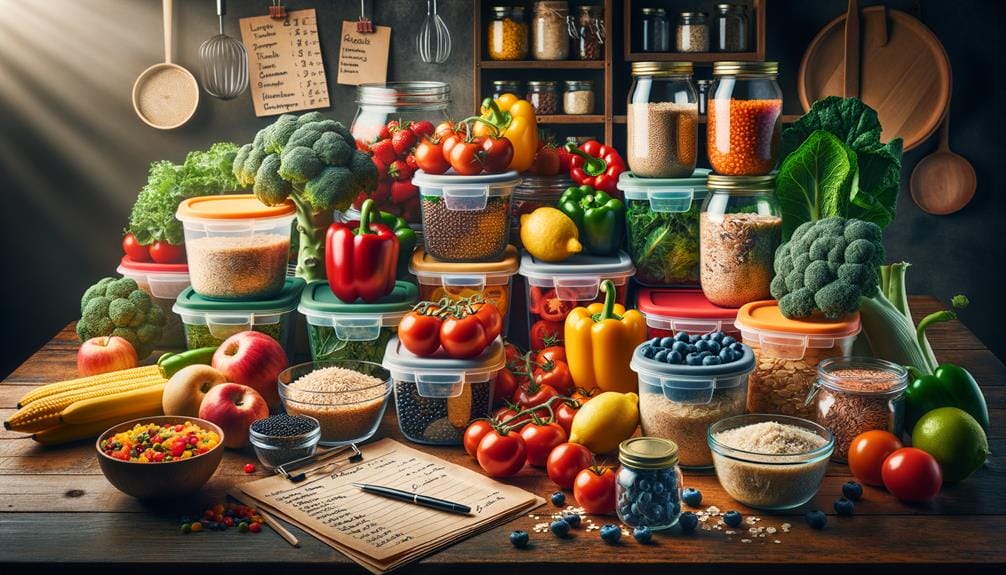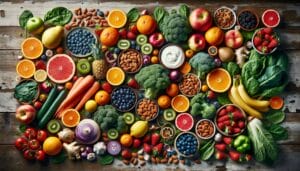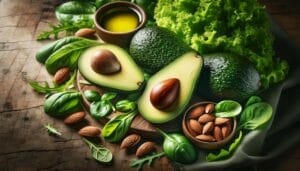You can eat healthily on a budget by planning your meals, buying in bulk, and opting for plant-based proteins. Meal planning guarantees you avoid last-minute takeout and stay within your budget. Stock up on bulk items to save money over time, and don’t forget to pick seasonal produce for fresh and affordable options. Plant-based proteins like beans and lentils offer nutritious, cost-effective alternatives to meat. Make the most of your groceries by utilizing leftovers, reducing food waste and extra spending. Follow these tips and you’ll discover more ways to save while maintaining a nutritious diet.
Key Takeaways
- Plan meals weekly to save money and avoid last-minute takeout.
- Buy in bulk to reduce cost per unit and stretch your budget.
- Incorporate plant-based proteins as affordable and nutritious alternatives to meat.
- Choose seasonal produce for peak flavor, nutritional value, and cost savings.
- Utilize leftovers creatively to minimize food waste and reduce grocery bills.
Plan Your Meals
Planning your meals in advance can help you save money and avoid last-minute takeout. Imagine, instead of frantically deciding between pizza or tacos at 7 PM, you’ve already got a wholesome, budget-friendly feast ready to go.
When you plan your meals, you can make a grocery list that includes only what you need. This reduces those sneaky impulse purchases that bust your budget. Plus, you can choose healthy recipes that fit your dietary goals.15
Buy in Bulk

Imagine this: buying in bulk can stretch your dollars further by reducing the cost per unit of essential items.
Imagine having enough whole grains, canned beans, and frozen vegetables to survive a zombie apocalypse, all while saving a pretty penny.
When you buy in bulk, you stock up on staple foods that store well and help you whip up meals without frequent, wallet-draining trips to the store.
Just remember, it’s not all fun and games; be mindful of expiration dates and storage guidelines. No one wants to find a science experiment in their pantry!
Choose Plant-Based Proteins
Choosing plant-based proteins like beans, lentils, and tofu is a smart way to save money while maintaining a nutritious diet. These affordable protein sources are packed with fiber, vitamins, and minerals, making them excellent alternatives to more expensive meat options.
Incorporating these versatile ingredients into your meals can help you meet your daily protein needs and lower your grocery costs.
Affordable Protein Sources
Plant-based proteins like beans, lentils, and chickpeas offer affordable, nutrient-dense alternatives to meat, making it easier to eat healthily on a budget. Dried beans, in particular, are a superstar for meatless meals, meeting your nutritional needs without emptying your wallet. Don’t know where to start? Check out this handy table:
| Protein Source | Benefits |
|---|---|
| Beans | Cheap, versatile, and high fiber |
| Lentils | Quick-cooking, protein-packed |
| Chickpeas | Great for salads and hummus |
Nutritional Benefits Explained
You’ll find significant nutritional advantages when you opt for plant-based proteins like beans, lentils, and tofu. These cost-effective alternatives are packed with essential nutrients and high in fiber, making them a fantastic choice for a balanced and nutritious diet. Plus, they won’t drain your wallet faster than your Wi-Fi after a Netflix binge.
Here’s why you should consider them:
- Fiber Frenzy: Legumes like chickpeas and black beans help with digestion and promote heart health.
- Versatile Tofu: It’s rich in plant-based protein, calcium, and iron, making it easy to incorporate into various dishes.
- Nutty Nutrients: Nuts and seeds offer healthy fats and micronutrients essential for overall health.
Easy Meal Ideas
For some budget-friendly meal inspiration, let’s explore a few easy and delicious dishes that highlight plant-based proteins like beans, lentils, and tofu.
Start your week with a hearty lentil soup that’s not only filling but also quick to make.
Craving tacos? Swap out expensive meat for black beans, and you’ve got a tasty, budget-friendly taco night.
Tofu stir-fries are another fantastic option; just toss in some veggies, soy sauce, and you’ve got a meal.
Chickpea salads are perfect for lunch, packed with fiber and protein to keep you going.
These meals will save you money, keep your diet balanced, and make healthy eating a breeze.
Incorporating plant-based proteins is a smart way to stay healthy without breaking the bank.
Opt for Seasonal Produce

Why not take advantage of the affordability and freshness of seasonal produce to enhance your meals? Opting for fresh produce in season means you’re getting fruits and veggies at their peak flavor and nutritional value. Plus, it’s a fantastic way to shop simple and save money.
Here’s how you can make the most out of seasonal goodies:
- Visit farmers markets: They’re gold mines for fresh, local produce at unbeatable prices.
- Plan your meals around what’s in season: This guarantees you’re eating a balanced diet without breaking the bank.
- Preserve excess seasonal produce by freezing or canning it for later use.
Utilize Leftovers

To make the most of your leftovers, transform them into new and exciting meals. Use leftover veggies for a flavorful stir-fry or hearty soup. Repurpose proteins like chicken or beef in tacos or salads. This approach not only minimizes food waste but also guarantees you enjoy a variety of dishes without spending extra.
Creative Meal Transformations
Transform your leftovers into exciting new meals with a few creative twists. Got leftover rice? Turn it into a tasty fried rice dish by adding vegetables, chicken, and seasonings.
Craving something light but filling? Use leftover roasted chicken to whip up a flavorful chicken salad with Greek yogurt, herbs, and chopped veggies.
Here’s a quick list to keep you inspired:
- Soup: Combine leftover vegetables, grains, and proteins with broth and seasonings for a hearty soup.
- Wraps: Turn yesterday’s grilled veggies into a delicious wrap with hummus and fresh greens.
- Buddha Bowl: Mix assorted leftovers like quinoa, roasted veggies, and beans, then drizzle with your favorite dressing.
Smart Portion Planning
Smart portion planning helps you make the most of leftovers, reducing waste and saving money on your grocery bill. Imagine taking yesterday’s roasted chicken and transforming it into a healthy, budget-friendly meal option. Toss those leftover proteins into a salad, sandwich, or stir-fry for a quick fix.
Did you shop and prepare too much quinoa? No problem! Mix those grains with veggies for a hearty soup or a grain bowl. You’ll feel like a culinary magician, turning scraps into gourmet delights.
Shop Smart

Creating a well-thought-out grocery list based on planned meals can help you avoid impulse purchases and stick to your budget. Start by prioritizing whole foods and comparing unit prices—those tiny stickers on shelves are your new best friends. Don’t forget to buy in bulk for non-perishables and stock up on sales.
Here’s a quick strategy to maximize your savings:
- Shopping List: Plan meals and stick to your list like it’s your grocery store bible.
- Unit Prices: Compare those sneaky shelf stickers to get the best bang for your buck.
- Coupons: Clip ’em like a pro and watch the savings roll in.
Shop smart, and your wallet will thank you.
Access Food Assistance Programs

Accessing food assistance programs like SNAP and local food pantries can greatly reduce the burden of grocery expenses for those in need. Don’t worry, you won’t have to trade your firstborn for fresh veggies. Government food support programs and community resources are here to help you tackle financial challenges while still enjoying healthy meals.
To get started, check if you meet the eligibility criteria—think of it as the golden ticket to nutritious food. Local food pantries can also be a lifesaver, offering a variety of items without the price tag. By exploring these options, you can alleviate the financial strain on your food budget and focus on whipping up those delicious and nutritious meals.
Conclusion
To sum up, you can master healthy eating on a budget by planning your meals, buying in bulk, and choosing plant-based proteins.
It’s no coincidence that opting for seasonal produce and utilizing leftovers also help keep costs down.
Shopping smart and accessing food assistance programs further stretch your dollars.
By following these strategic steps, you’ll find that eating well doesn’t have to be expensive.
Start today, and you’ll see both your health and budget improve.









Leave a Comment